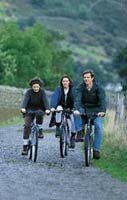|
 With the decline in importance of the mountain bike, the cycle industry is trying to identify the 'next big thing'. This is likely to be town/trail bicycles aimed at casual leisure users and suppliers are increasingly adding such comfortable bikes to their range. With the decline in importance of the mountain bike, the cycle industry is trying to identify the 'next big thing'. This is likely to be town/trail bicycles aimed at casual leisure users and suppliers are increasingly adding such comfortable bikes to their range.
Developments such as automatic gear shifting, electric assist bikes and enclosed hub gears married to light-powering dynamos are being coupled with suspension seat posts, relaxed frame angles and mudguards fitted as standard to make the everyday bicycle a much more attractive option for new and 'born again' cyclists.
The vast majority of new cyclists are returning to cycling after learning to ride as a child. 90 percent of men and 67 percent of women know how to ride a bike. (Source: On Your Bike: Cycling Patterns, Benefits, Constraints and Recommendations, Sharp, I, National Forum for Coronary Heart Disease Prevention, London, 1990).
However, a worrying trend for the future is that, because of perceived road danger the number of children allowed by their parents to ride their bikes on local roads has fallen dramatically in a generation, from 75 percent in 1971 to 25 percent in 1990. (Source: One False Move, Hillman, M., Adams, J, Whitelegg, J, Policy Studies Institute, 1990).
72 percent of leisure cyclists consider that traffic-free cycle routes are the most important facility in encouraging utility cycling. (Source: Transport Implications of Leisure Cycling, G. Gardner, Transport Research Laboratory, 1998).
The Benefits of cycle tourism
Demand for cycle tourism trips will increase by up to 10 percent within the next seven years. (Source: Cycling Opportunities, Making the Most of the National Cycle Network, Simon Holt Marketing Services, 1996).
A survey in the UK's Peak District National Park found that those cycling while on holiday in the Park spent an average of £25 per person per day. The average spend of a car-borne (or other) day visitor was just £7.30 a day. This is because cyclists have to shop locally, whereas drivers can buy in a lot of their provisions etc and store them in the car. (Source: Cycling Opportunities, Making the Most of the National Cycle Network, Simon Holt Marketing Services, 1996).
|